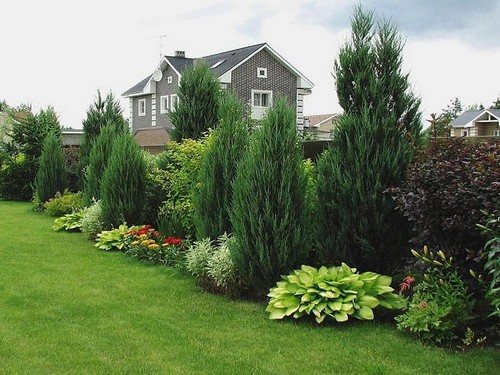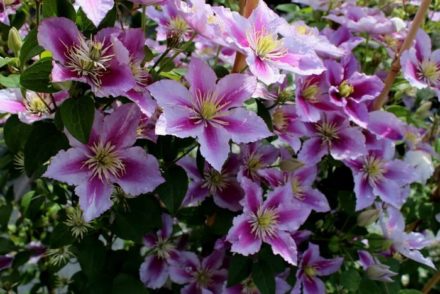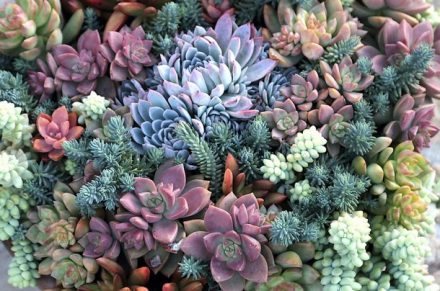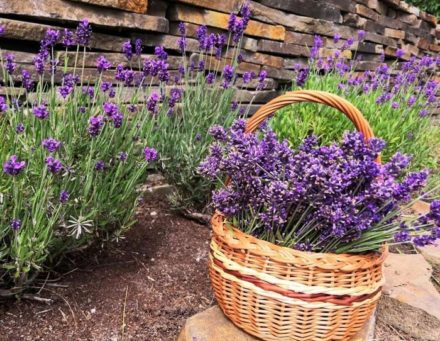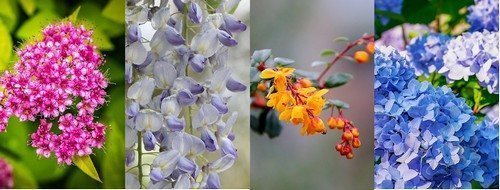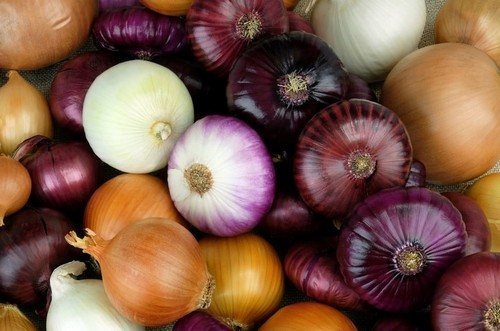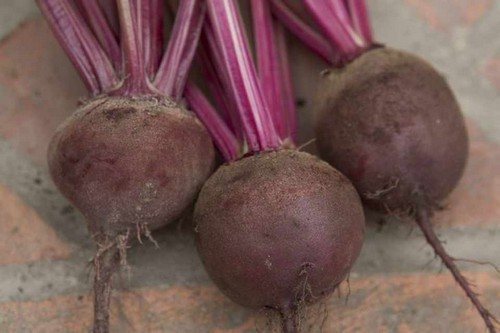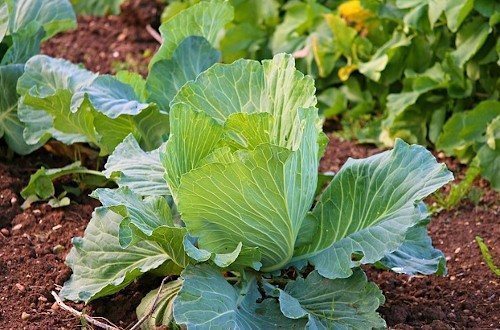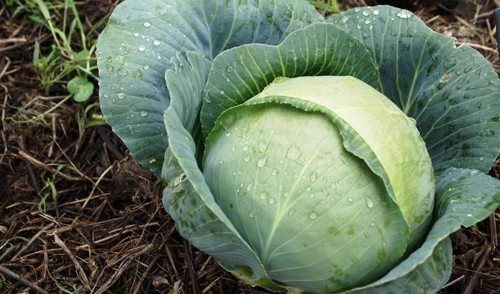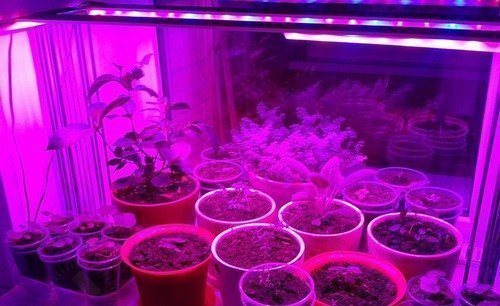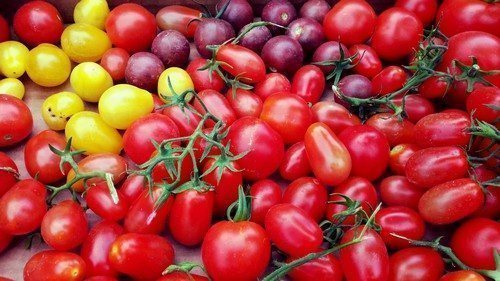An interesting alternative to a traditional capital fence made of wood, stone or metal is a hedge. A fence made of living plants not only delimits space, but is also an essential element of the site's decor.
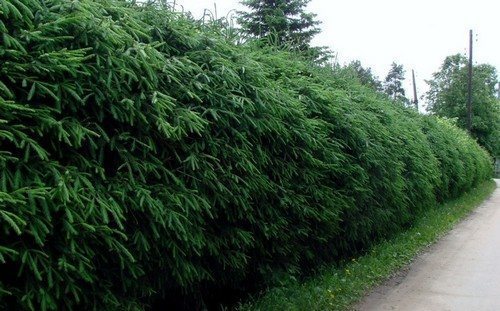
- Purpose of a hedge
- General requirements for plants
- Classifications
- By plants used
- By composition and structure
- By height
- By planting technique
- Choosing plants for a hedge
- Fast-growing
- Evergreen
- Perennial
- Conifers
- Deciduous
- Climbing
- Shrubs
- Flowering
- Fruit-bearing
- Trees
- What is the best way to make a hedge
- 27 best plants for a hedge
- Cotoneaster lucidus
- Thunberg barberry
- Common hornbeam
- European beech
- Cherry laurel
- Thuja
- Brabant
- Smaragd
- Column
- Wisteria
- Willow
- Yew
- Dogwood
- Maiden grapes
- Hawthorn
- Spiraea
- Rosehip
- Physocarpus
- Privet
- Mock orange
- Climbing rose
- Cupressocyparis Leyland
- Wisteria
- Hydrangea
- Common ivy
- Boxwood
- Spruce
- Common juniper
- Dwarf mountain pine
- Yellow acacia
- Planting and care
- Principles of planting placement
- Regular pruning
- Formed plantings
- Unformed hedges
- Protection from pests and diseases
- Care tips
- Frost-resistant options
- Undesirable plants for hedges
- Creating a hedge with your own hands at the dacha
- Ideas for hedges
- Mixed
- Zoning space
- "Reliable rear"
- Hedge border
- "Blooming Garden"
- Playing with shapes
- Geometric shapes from perennial plants
- "Wavy Fence"
- Blooming wall
- Mix
- "Different Ensemble"
- Improvisation with an old fence
- Photos of hedges
Purpose of a hedge
Like a regular hedge, a fence made of living plants performs a restrictive function. Some types of fences, consisting of thorny plant species with a dense crown, are not inferior in reliability to wooden or metal structures. Neither man nor animal can overcome such a wall.
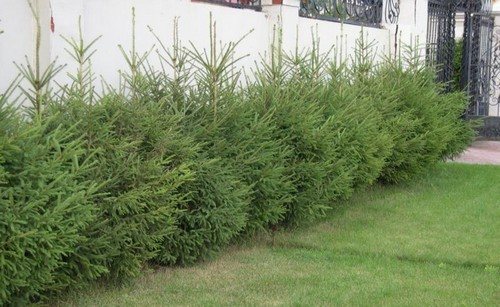
On a note. A solid fence made of deciduous trees, 2-2.5 m high, can significantly reduce the noise level coming from the street. Hedges block polluted air from entering the site, acting as natural filters.
“Living walls” are used to zone a site and camouflage various objects (gazebos, compost heaps, outbuildings). This role is played by decorative varieties of grasses (vines), flowers and shrubs. The perception of the space of the entire site depends on the species composition of the fence, its size and shape.
Additional functions that a hedge successfully copes with:
- attracts birds and beneficial insects to the site;
- serves as a windbreak and keeps snow from being blown out of the area;
- strengthens the soil on slopes, preventing erosion;
- Some plants release healthy phytoncides into the atmosphere.
The installation of hedges allows the gardener to make the appearance of the site unique and protect the interior space from unfavorable external conditions.
General requirements for plants
The main feature that unites all crops suitable for planting as a hedge is unpretentiousness.The selection includes seedlings that are drought-resistant, wind-resistant and unpretentious to soil fertility. If the hedge is planted within the city limits, to the specified qualities is added resistance to external pollution: dust and soot settling on the foliage.
Plants should easily tolerate dense planting and regular pruning. Due to thickened planting and intensive cutting, a dense and impenetrable structure of the structure is obtained.
When choosing crops for constructing a hedge “from scratch,” preference is given to fast-growing varieties. A hedge made up of such specimens will reach the required dimensions within 4-6 years after sowing the seeds.
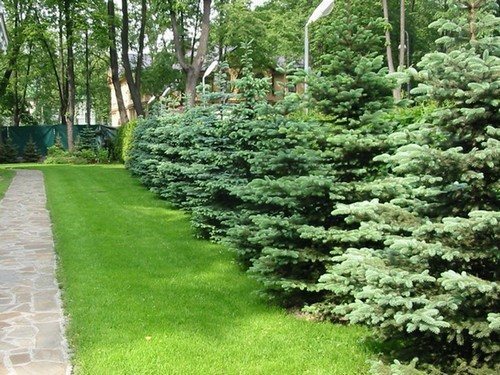
Classifications
Hedges are divided into several groups, depending on the height, shape and species composition of the composition. Each group has its own characteristics of care and serves to perform different tasks.
By plants used
According to the type of plants included in the composition, fences are:
- deciduous (dogwood, euonymus, maple, barberry);
- blooming (spirea, lilac, mock orange, rose hips);
- evergreens (conifers);
- climbing (hops, maiden grapes).
There is a practice of creating fences from fruit bushes and trees: currants, gooseberries, cherries, ranetka apple trees. Such a fence, in addition to its protective function, plays the role of a supplier of berries and fruits.
By composition and structure
A hedge can be made up of plants belonging to the same species and variety. This composition is called “uniform”, and is popular in classical and regular gardens.
Combined hedges are planted with plants of different species.Growing up, they imitate the natural landscape, organically combining in height, crown density and foliage color.
Climbing plants are used in the construction of “trellis” structures. Flexible shoots are evenly distributed over the base (metal or plastic mesh, wooden sheathing), intertwining with each other.
By height
Living fences are classified according to height into 4 types:
- border (height up to 40 cm);
- low (up to 100 cm);
- medium (from 100 to 150 cm);
- tall (over 150 cm).
Low and medium fences are made up of shrubs, high fences are made up of trees (oak, linden, maple, lilac).
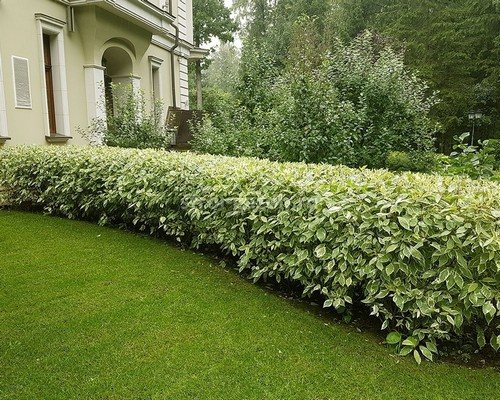
By planting technique
A living fence can be artificially formed and freely growing.
Using systematic trimming, hedges with a clear crown geometry are created. They look impressive, but require regular pruning throughout their life.
When forming freely, plant branches are not subjected to formative pruning. For this type of fencing, crops with a beautiful natural crown shape are selected. They only require sanitary pruning.
Choosing plants for hedges
The selection of plants for hedges is taken with the utmost seriousness. The appearance, durability and practicality of the fence depend on the correct choice. Should be considered:
- the adaptability of the crop to the climate of the area and the soil on the site;
- seedling growth rate;
- compatibility in appearance and care requirements (for combined plantings).
It is worth deciding on the amount of care that the gardener is willing to provide to the plants. Some species require not only pruning, but also watering and fertilizing.
To arrange a fence you will need not 5-10, but tens, hundreds of plants.Therefore, the cost of seedlings also matters.
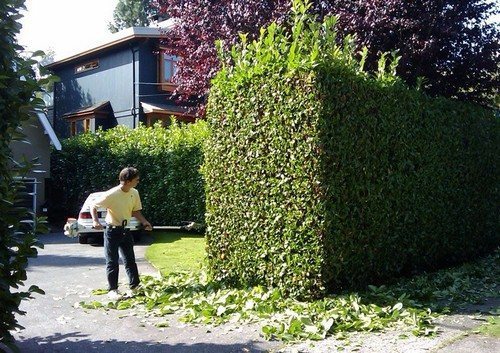
Fast growing
A group of shrubs that grow by 20 cm or more per season. Within a few years after sowing seeds or planting seedlings, the plants reach the size of an adult specimen.
The most common types:
- dogwood;
- vesicular carp;
- barberry;
- damson;
- Amur lilac;
- hawthorn;
- hazel (hazel);
- hop;
- grape;
- caragana tree (chiliga);
- sucker;
- irga;
- viburnum;
- mock orange;
- Russian maple;
- rose hip;
- spirea.
Evergreens
A group that retains foliage for a year or longer. The appearance of the fence remains unchanged in winter and summer.
Year-round preservation of foliage is typical for tropical plants that are not able to grow in the domestic climate. In the southern regions of the country, evergreens are cultivated rhododendrons. Ledum retains its greenery and tolerates mild winters well.
Perennial
Almost all plants used for making hedges are perennial. The exception is fast-growing vines (morning glory, Turkish beans, hyacinth beans), which in the Russian climate are grown as an annual crop.
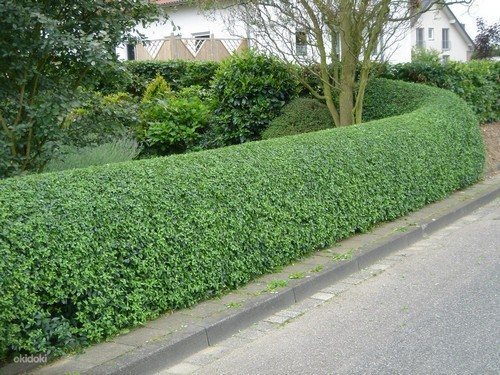
Conifers
Hedges made from coniferous species look impressive and expensive. However, coniferous varieties are more capricious than deciduous ones. In particular, the needles of some species suffer from sunburn in winter, turning yellow and falling off.
The most attractive and resistant to adverse conditions plant is the thuja. Its varieties (western and eastern) tolerate frosty winters well, are drought-resistant and tolerate the gas pollution of a big city. Thuja has an attractive cone-shaped or columnar crown shape, soft and dense needles of bright color.Breeders have created thuja varieties especially for decorative hedges: Smagard, Brabant.
In addition to thujas, spruce, junipers (common, Cossack), fir, cypress (only in the southern regions), and yew are used in the construction of living partitions.
Hardwood
Represented by hundreds of varieties of trees and shrubs. They are unpretentious, frost-resistant, but decorative during the warm season. In winter, deprived of foliage, they do not look attractive.
Curly
They have flexible and long shoots. In some varieties, the shoots are equipped with tendrils to facilitate fastening to a support. The most popular:
- girl's grapes;
- ivy;
- hop;
- climbing rose;
- honeysuckle;
- actinidia;
- clematis;
- wood plier;
- large-leaved kirkazon.
Morning glory and Turkish beans are popular options for creating “green walls” for one season.
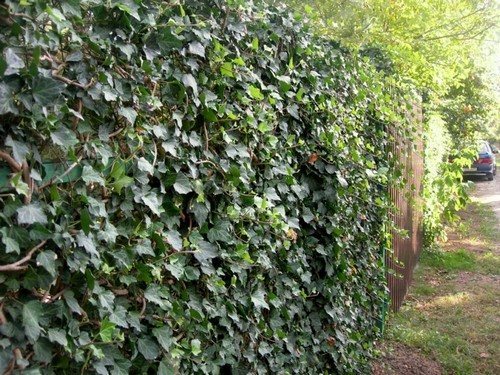
Shrubs
Hundreds of species of shrubs are suitable for growing as hedges. Preference is given to unpretentious species with beautiful foliage:
- barberry;
- caragana tree;
- vesicular carp;
- euonymus;
- heather;
- shrubby cinquefoil;
- derain;
- sucker.
Blooming
The following representatives of the flora have bright and long-lasting flowering:
- spirea;
- rose hip;
- lilac;
- mock orange (garden jasmine);
- forsythia;
- rhododendron;
- hydrangea;
- almond;
- action;
- bloodroot;
- budleya David;
- broom.
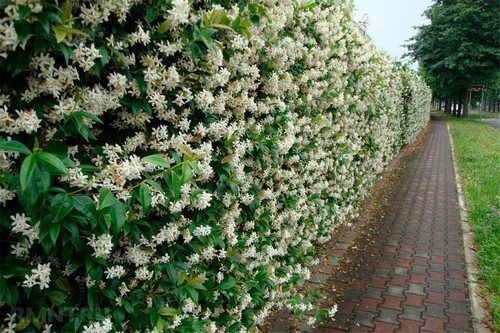
Fruit bearing
You can combine beauty and benefit in a hedge by planting fruit bushes:
- red and golden currants;
- gooseberry;
- damson;
- felt cherry;
- irga;
- honeysuckle;
- viburnum;
- sea buckthorn;
- barberry;
- japonica;
- blackberries, raspberries.
Trees
With proper care, any unpretentious trees can act as a living fence.Particularly popular are:
- oak;
- elm;
- Linden;
- maple;
- willow;
- Rowan;
- lilac;
- spruce.
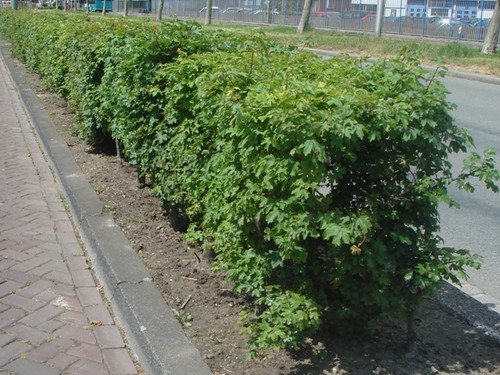
What is the best material to make a fence from?
Before purchasing seedlings, you need to decide what type of fencing will be. For a free-form composition, several types of trees and shrubs of different sizes are selected. To create strict cropped forms, species with a dense crown and small foliage are suitable.
It is necessary to study the soil types on the site and know its illumination. Some plants (elion, almond, sea buckthorn) need light sandy soils and bright lighting, others (hydrangea, rose hips) need fertile soils with good moisture.
27 Best Plants for Hedging
Each plant suitable for planting as a fence has its pros and cons. A brief description of popular tree and shrub species suitable for creating hedges will help make the final choice easier for the gardener.
Cotoneaster brilliant
An unpretentious deciduous plant. Forms a cushion-shaped bush, with straight shoots reaching a height of 3 m. The leaves are ovoid, glossy bright green, 3-5 cm long. In autumn, the crown turns brownish-purple.
Blooms in late spring with numerous small pink flowers for about 4 weeks.
Advantages: drought-resistant, does not require fertile soil, easily tolerates pruning.
Disadvantages: affected by fusarium.
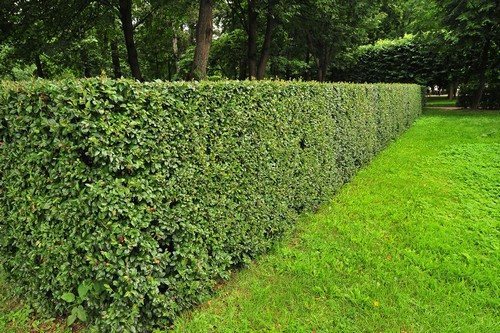
Barberry Thunberg
Arched reddish prickly shoots form a bush, 2-2.5 m high. The leaves are small, round, green (bright purple in autumn). The flowers are small, yellow, forming bunched inflorescences. Blooms in May. In autumn, scarlet shiny fruits, up to 10 mm long, ripen on the Thunberg barberry.
Advantages: winter-hardy, tolerates partial shade.Planted on slopes, it keeps the soil from sliding.
Disadvantages: requires humus-rich, loose soil and regular watering. Barbed.
Common hornbeam
A powerful tree, a close relative of the birch. The height of the trunk can reach 20 m, but is more often limited to 10 m. The crown is dense, the leaves are oval, 12-15 cm long.
Advantages: lush crown, shade tolerance.
Disadvantages: slow growth, not frost-hardy.
European beech
The reddish beech trunk reaches a height of 40 m, a diameter of 120-140 cm. The structure is columnar. Lifespan – up to 5 centuries.
The leaves are light green, smooth, rounded-toothed.
Advantages: resistant to dust and smoke, responds to pruning by thickening the crown, grows well on rocky soils.
Disadvantages: does not tolerate drought.
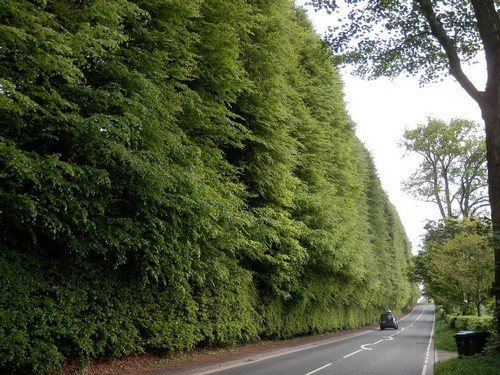
Lavrovishnya
An evergreen plant in a subtropical climate that grows up to 4-5 m in height. The leaves are shiny, leathery, up to 20 cm in length, similar to laurel leaf blades. Blooms with racemose white inflorescences in May. The fruit is similar to a cherry drupe, 7-9 mm in diameter.
Advantages: unpretentious ornamental and medicinal plant with edible fruits.
Disadvantages: does not grow north of the Black Sea coast.
Thuja
An evergreen plant with scaly needles. In nature it can reach a height of 70 m. In cultivation, tree growth is limited to 5-7 m. The crown is dense, columnar, cone-shaped or ellipsoidal.
Advantages: frost resistance, low watering requirements and resistance to polluted air. Thuja hedges are decorative all year round.
Disadvantages: suffers from sunburn at the end of winter, causing the needles to turn yellow and fall off.
Brabant
Western thuja variety. The seedlings grow quickly, increasing in size by 20-30 cm annually.In the climatic conditions of Russia, the tree reaches a height of 3-4 m. It has a cone-shaped shape and a dense crown.
The branches are flat and grow perpendicular to the ground. The color of the scaly needles is bright green (in the Gold variety it is golden). The cones on the branches are small and brown in color.
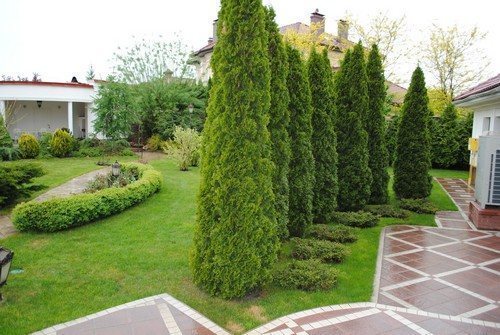
Emerald
Another variety that forms columnar trees, similar to cypresses, up to 6 m high. In terms of growth speed, Smaragd is inferior to Brabant, adding 12-18 cm annually.
In addition to specimens with green needles, there are also ones with yellow and light green needles.
The tree is easy to trim and can be given different shapes.
Columna
The tree grows as actively as its relatives - 15-25 cm per year. At the age of 10 years, its size is 3-3.5 m in height and up to 1.5 m in diameter. The crown has a regular columnar shape and does not need pruning. Requires a minimum of care.
To plant thuja Columna, you should choose a sunny area, protected from strong winds. Not picky about soil type.
Wisteria
A climbing plant growing in the subtropics. Attractively lush and fragrant flowering. The length of the vine can reach 16 m. It blooms in early April with purple, white and blue racemose inflorescences.
Pros: blooms.
Disadvantages: does not winter north of the Black Sea coast.
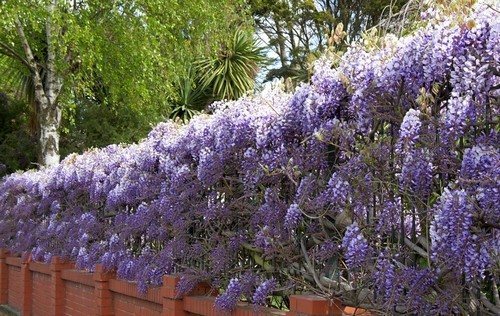
Willow
She is: willow, willow, willow, willow. A moisture-loving tree or shrub with beautiful flowing shoots and narrow silver-green leaves. The genus includes more than 500 species, from very miniature creeping plants to giants, 40 m high.
The following types of willow are suitable for hedges: dwarf, brittle, tufted willow, red willow, basket willow, Caspian willow, shelyuga, purple.
Advantages: unpretentiousness and frost resistance, fast growth.
Disadvantages: does not tolerate drought.
Yew
For planting, Yew berry (European) is used as a fence. Long-lived, capable of growing for several thousand years. The height of the tree reaches 20 m, but more often it is limited to 8-10 m.
The yew crown is dense, the needles are bright green. The seeds ripen in scarlet-colored cones. Can be formed into a low lush bush or a tall spreading tree.
Advantages: longevity, bright color of needles and pine cones.
Disadvantages: all parts are poisonous! Yew is damaged by frost.
Derain
Belongs to the Dogwood family. The deciduous shrub or compact tree has bright red or red-brown bark. The foliage is small, green. White Derain has a variegated leaf plate, the green background is lined with white stripes.
Advantages. It is winter-hardy, unpretentious, easy to trim, and forms a dense crown.
Disadvantages: requires regular watering.
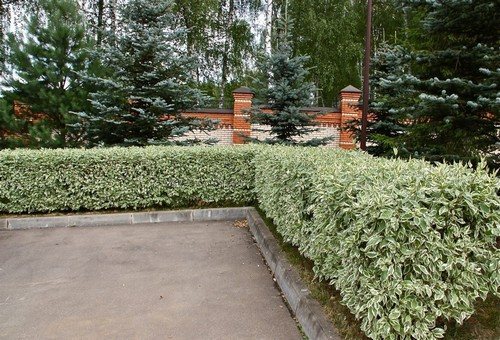
Maiden grapes
The most common vine used for hedges. Its shoots can reach a length of 7-9 m. They are completely covered with large 5-lobed or 3-lobed shiny leaves. The foliage is green in summer and turns purple in autumn.
Advantages: winter hardiness, unpretentiousness, rapid growth (up to 1 m per year), shade tolerance, undemanding to soil fertility.
Disadvantages: requires strong support and regular formative pruning.
Hawthorn
The crown of the tree is spherical, the branches have thorns, up to 8 cm long. The leaves are oval, jagged, the fruits are small apples, collected 5 pieces in a cluster.
Advantages: unpretentiousness, winter hardiness, durability (lives up to 300 years). A dense hedge made of thorny hawthorn is a reliable barrier from people and animals.
Disadvantages: moisture-loving. The thorns make it difficult to trim.
Spirea
An extensive group of shrubs with beautiful flowering and an interesting crown shape. There are dwarf varieties, 20-30 cm high, the largest reach 2.5 m in height and in diameter. The leaves are small, of different shapes. Blooms abundantly, white, pink, lilac.
The most popular in gardening are Japanese spirea, birch-leaved, gray, white, willow-leaved, virginian, and Vangutta.
Advantages: abundant flowering, unpretentiousness.
Disadvantages: require fertile and loose soil.
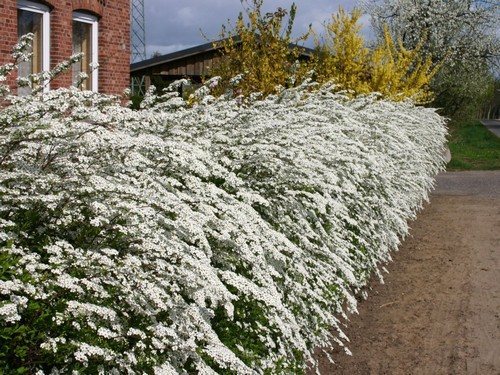
Rose hip
To create an impenetrable and decorative fence, wrinkled, gray and prickly varieties of plants are used. Rosehip bushes reach a height of 2 m, the shoots are straight and prickly. In May, the bushes bloom with fragrant white or pink flowers.
Advantages: unpretentiousness, abundant flowering.
Disadvantages: forms a lot of growth that needs to be cut out.
Bladderwort
The viburnum-leaved variety of bladderwort forms a lush bush, 2-3 m high, with drooping shoots. The foliage is light green, purple, light green, yellow, depending on the variety. It blooms with white or pink rounded inflorescences.
Advantages: unpretentious, shade-tolerant.
Disadvantages: does not tolerate flooding.
Privet
Heat-loving shrub from the Olive family. The foliage is elongated, light green, the flowers are small white, and smell pleasant. The fruits are black, shiny, poisonous.
Advantages: shade-tolerant, tolerates shearing well, is not afraid of drought.
Disadvantages: not cultivated north of the Caucasus and Crimea.
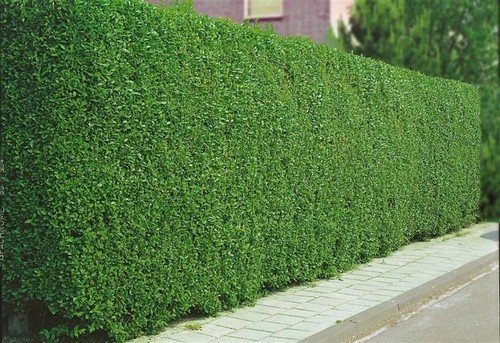
Chubushnik
A fragrant, beautifully flowering shrub called “garden jasmine”. Height from 1.5 to 3 m. The flowers are white, large, collected in lush inflorescences. Flowering lasts more than 3 weeks.
Advantages: lush flowering, tolerates partial shade, frost-resistant.
Disadvantages: moisture-loving.
climbing rose
A liana reaching a length of 5 m. For 1-2 months, the shoots are covered with double white, yellow, and scarlet flowers.
Advantages: lush flowering.
Disadvantages: for the winter it is necessary to remove the shoots from the supports and cover them.
Cupressociparis Leyland
Ephedra, a relative of Cypress. It is distinguished by a dense crown and rapid growth, the annual growth reaches a meter. The height of an adult tree is 15-18 m.
Pros: Grows quickly.
Disadvantages: thermophilic, requires regular moisture and fertile soil.
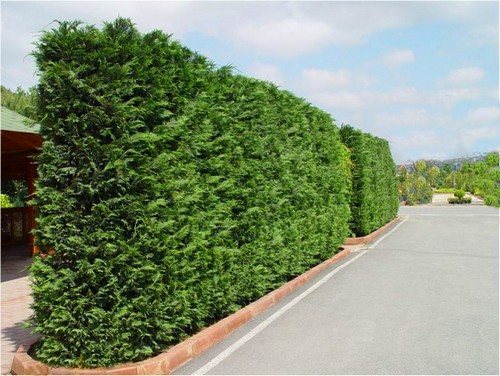
Wisteria
A climbing vine from a subtropical climate. Forms lignified shoots, 15 m long. Inflorescences are racemose, purple, fragrant.
Advantages: lush flowering, fast growth.
Disadvantages: not grown in open ground north of Crimea.
Hydrangea
Flowering shrub reaching 3-4 m in height. The leaves are large, light green. The inflorescences are spherical, up to 25 cm in diameter, white, purple, blue, pink.
Advantages: flowering shade-tolerant plant.
Disadvantages: requires regular watering and acidic soil.
Ivy
An evergreen vine with five-pointed shiny leaves. Can grow up to 30 m in height.
Advantages: fast growth.
Disadvantages: does not winter north of the Black Sea coast.
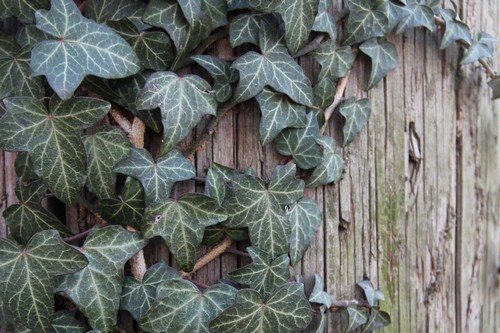
Boxwood
An evergreen deciduous plant that grows well in subtropical climates. It tolerates haircuts well and forms a dense, small-leaved crown.
Advantages: shade-tolerant, foliage is dark green and shiny.
Disadvantages: grows slowly, does not tolerate frost.
Spruce
An unpretentious tree with a pyramidal crown. For hedges, prickly spruce and common spruce are used.
Advantages: fast growth, frost resistance.
Disadvantages: difficulties in plant formation.
Common juniper
Conifer, forming a spreading bush, 1.5-3 m high. The needles are small and sharp. Ripe cone berries are blue-black in color.
Advantages: unpretentious, winter-hardy, shade-tolerant.
Disadvantages: moisture-loving.
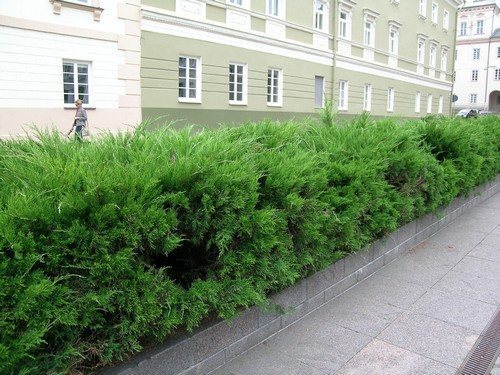
Dwarf mountain pine
To create hedges, breeders have bred dwarf forms of pine trees, not exceeding 2.5 m in height. The trees have a spherical or cushion-shaped crown and a very dense arrangement of needles. The most popular: Mugus, Schmidta, Gnome.
Advantages: winter hardiness, unpretentiousness.
Disadvantages: slow growth, impossible to propagate on your own.
yellow acacia
Another name is caragana tree. Drought-resistant shrub with small foliage and abundant yellow flowers. Loves light and sandy soil. Good for cutting.
Advantages: unpretentious, winter-hardy.
Disadvantages: does not tolerate dampness and shade.
Planting and care
For planting, choose autumn or spring, regardless of whether seedlings or seeds are used. The soil is freed from weed roots and the necessary additives are added (sand, humus, mineral fertilizers).
Principles of planting placement
Seedlings are planted in a row. The distance between plants in a row is 2 times less than with conventional planting:
- for bushes 30-60 cm;
- in trees 1-1.5 m.
The denser the seedlings grow, the more reliable the fence.
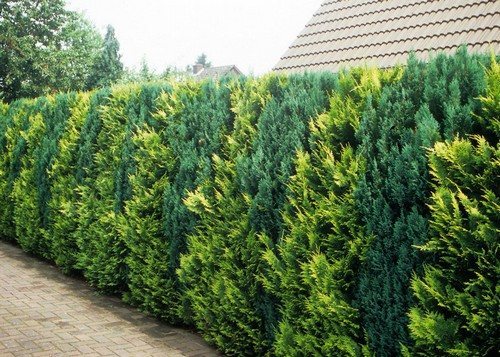
Regular haircut
Plants begin to be cut from the second year after planting.In spring and autumn, sanitary (sick and weak shoots are removed) and formative pruning is carried out. The latter is aimed at giving the hedge a certain shape and enhancing the tillering of plants.
Molded plantings
To give plants a strict geometric shape, special templates are used.
To give the crown density, the main shoots are regularly cut, encouraging dormant side buds to grow. The procedure is carried out up to 2 times per season.
Unshaped hedge
A sanitary haircut twice a year is sufficient.
Pest and disease protection
Treatments with insecticides and fungicides will help protect plants from diseases and pests. For rot and fungal diseases use: Fufanon, Strobi, Profit Gold.
They will save you from pest invasion: Akarin, Kinmiks, Aktara.
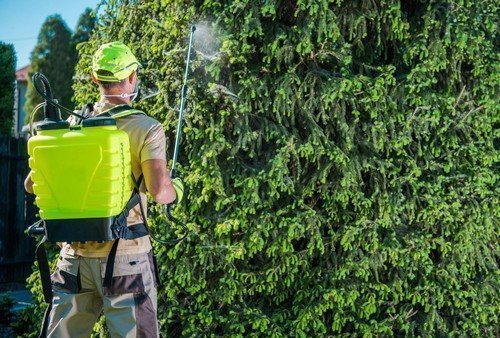
Care Tips
It is better to feed a hedge by spraying it on the leaf.
It is recommended to thin out particularly dense hedges to allow light and air into the crown.
Frost-resistant options
In a region with harsh winters, the following plants are used in hedges:
- fur tree, pine tree;
- broom, caragana;
- hawthorn, hazel, rowan, willow.
Undesirable plants for hedges
You should not use plants that require a lot of space to grow and can inhibit the development of neighbors (walnuts, black currants).
Tender crops that require special care should be avoided.
Creating a hedge with your own hands at the dacha
To construct a fence of this type, you will need to calculate the number of seedlings based on the length of the fence and the spaces between the plants.To work, you will need a shovel and a cord with stakes to mark the planting row.
Holes are dug in the marked row into which the seedlings are immersed. If necessary, complex fertilizer is applied to the holes. After planting, the bushes are watered abundantly.
If sowing is carried out with seeds, they are placed densely to save space. After germination, excess specimens are replanted.
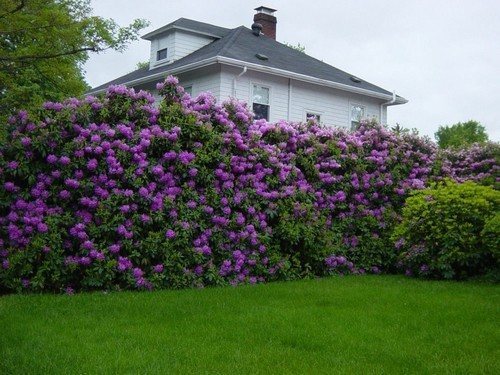
Hedge ideas
The most popular are hedges made of conifers and deciduous shrubs with lush flowering or variegated foliage.
Mixed
Several types of plants are planted in a row, achieving a harmonious combination of their height and crown structure. Successful combinations:
- Thuja Brabant, red-leaved bladderwort;
- juniper, Thunberg barberry;
- low-growing spirea, thuja or rowan in the background.
Space zoning
For zoning the site, low varieties of shrubs are used: bladderwort, derain, spirea, cinquefoil. Arborvitae and cypress trees are good for creating smooth partitions.
To create secluded “green rooms”, vines and vines are used, braiding supports with them.
"Reliable rear"
The impenetrable fence is grown from caragana, prickly spruce, acacia, hawthorn, rose hips, and thorns. An internal frame made of metal strips will provide additional reliability to the fence.
hedge border
Low-growing fencing is obtained by planting heathers, cinquefoil, and low-growing spirea. During one season, marigolds, chrysanthemums, kochia, cirenaria, petunia, and ornamental cabbage will delight you.
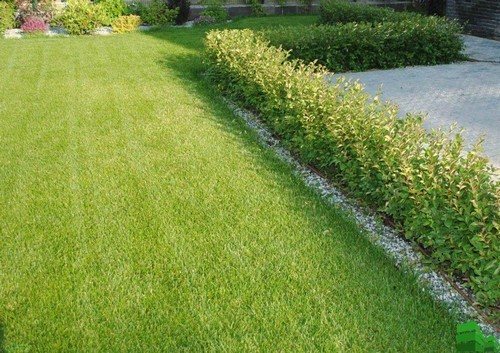
"Blooming garden"
For a long-flowering hedge, plants with different flowering periods are selected:
- forsythia, spirea, Japanese quince;
- damson, rose hips, broom;
- lilac, spirea, cinquefoil;
- mahonia, almond, mock orange.
Playing with shapes
For the fence, plants with different crown shapes and foliage structures are selected. Different shapes are obtained by cutting.
Geometric shapes from perennial plants
The crown of the seedlings is given the shape of a cube, ball, parallelepiped, or cone. A combination of figures of different sizes and plants with different crown structures looks impressive. For example:
- cubes made of thuja, cypress and pear;
- a ball of mountain pine, cone-shaped thuja or yew.
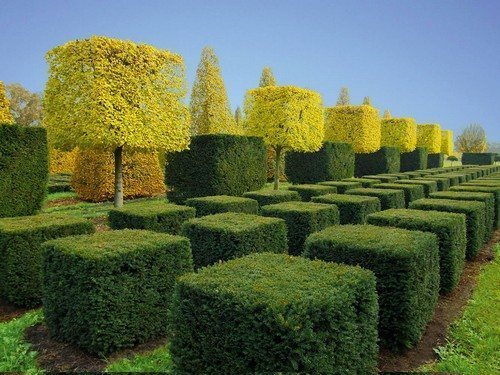
"Wavy Fence"
Using pruning, the surface of the green wall is made wavy. Shrubs lend themselves well to shaping: turf, broom, privet.
Blooming wall
Several types of plants are combined in terms of growth and flowering duration. For example: lilac (hawthorn), mock orange (rose hip, viburnum), spirea, cinquefoil, astilbe.
Mix
Fences consisting of plants and additional elements look impressive: wickerwork, stone walls, gabions, decorative trellises.
"Different Ensemble"
Eclecticism is coming into fashion - a combination of shrubs and climbing plants in one row. To these are added spans of picket fence or blind stone fencing.
Improvisation with an old fence
Another durable, but unsightly old fence can be decorated with climbing plants (morning glory, grapes, honeysuckle).
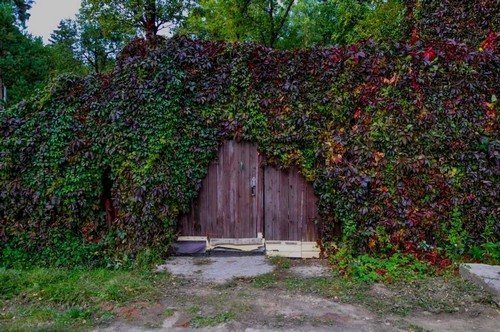
Photos of hedges
Some examples of successful ideas for hedges.
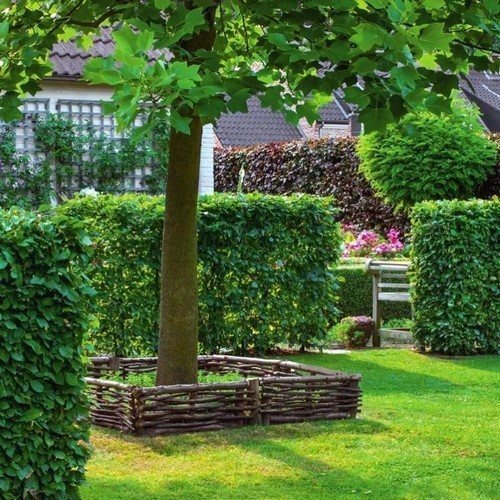
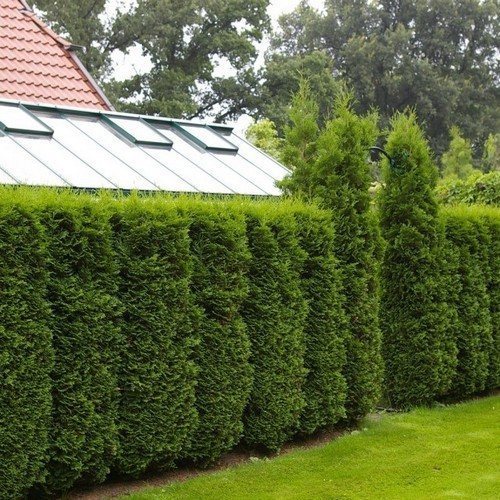
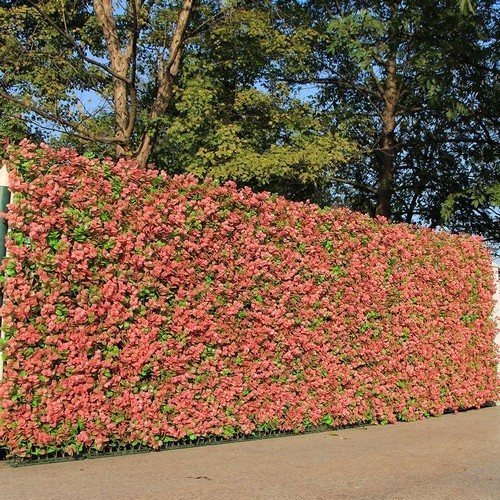
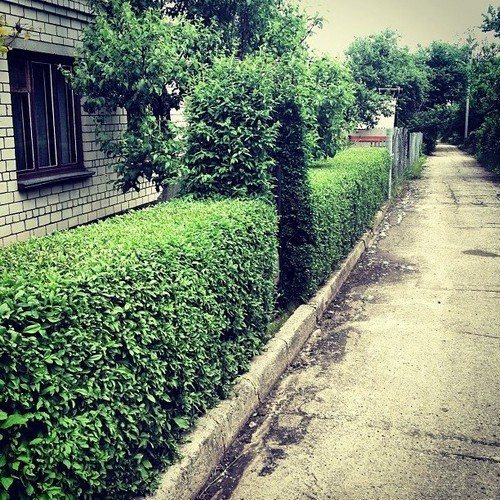
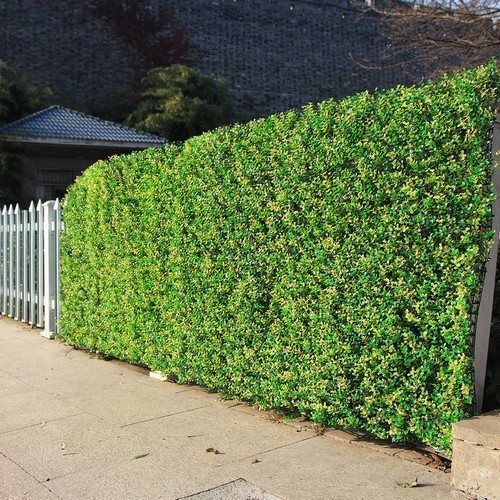
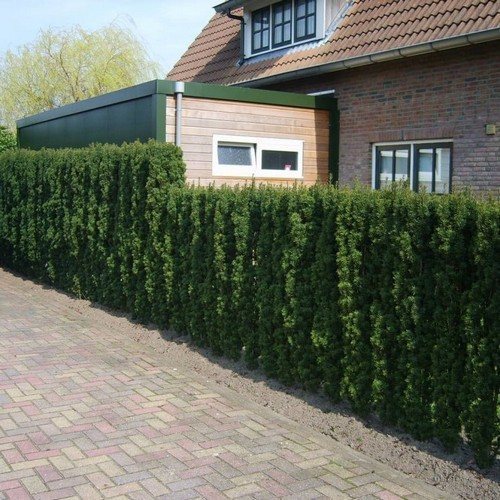

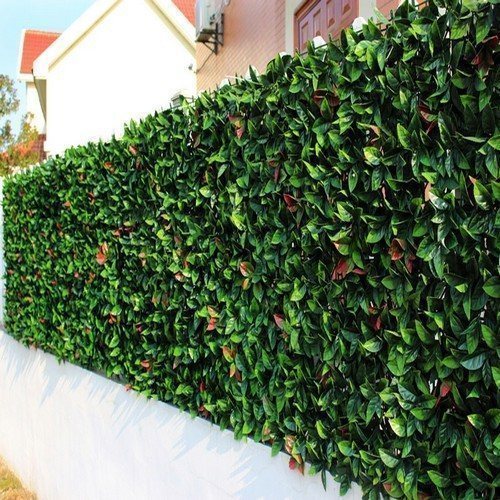
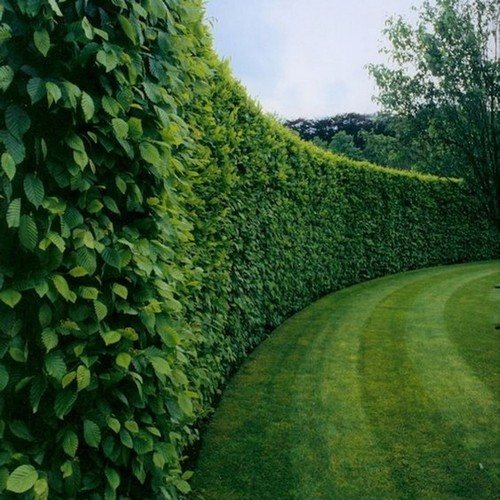
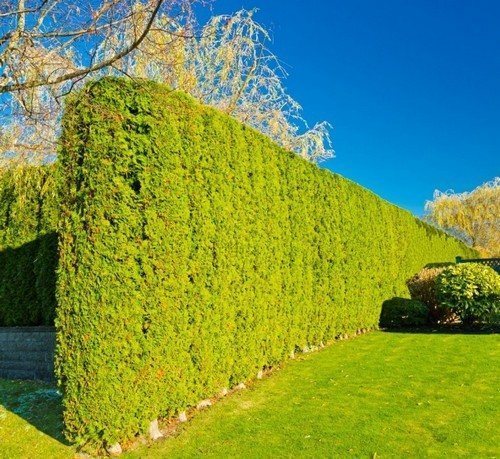










Creating a hedge on a summer cottage is not an easy, but exciting job. It will take several years from planting the plants to completing the fence. But the finished fence will give the site a unique look.


